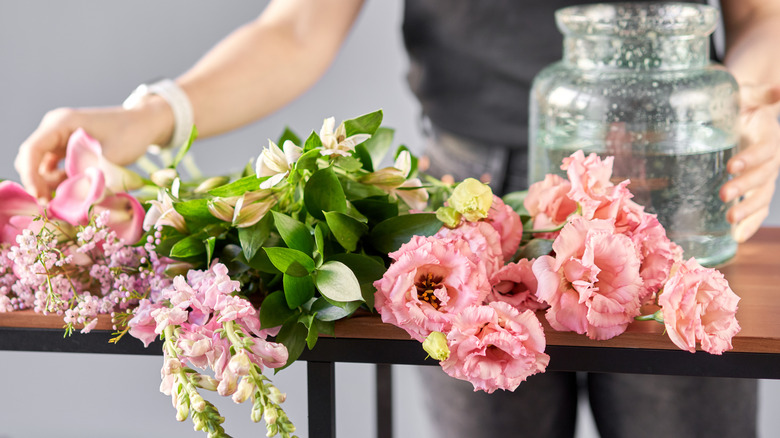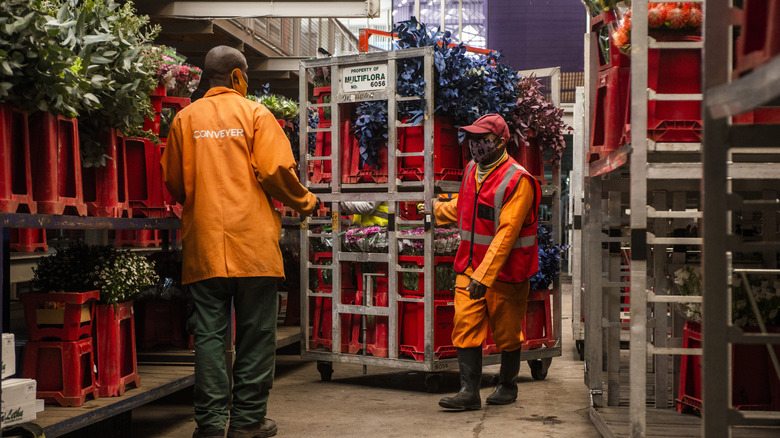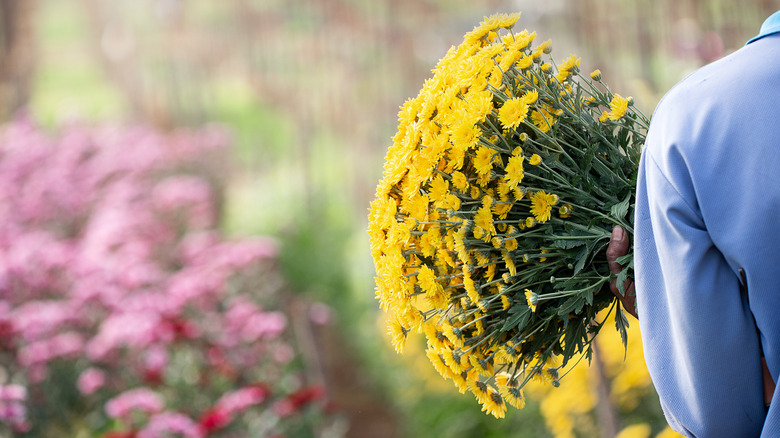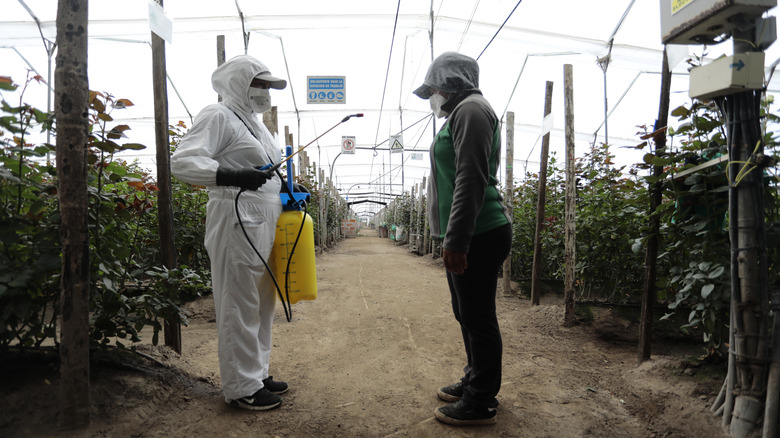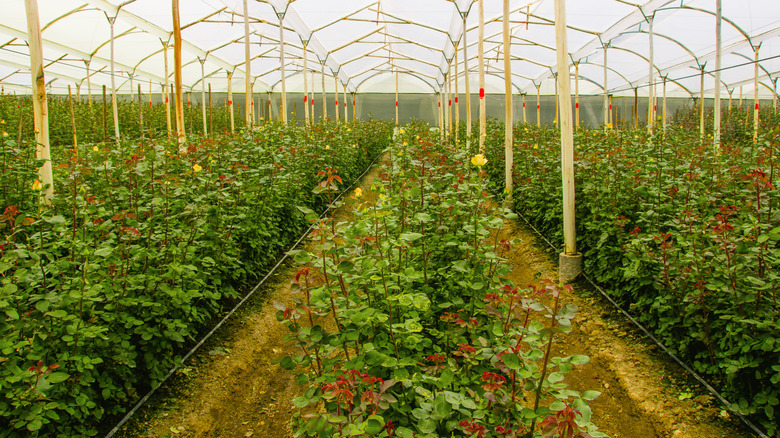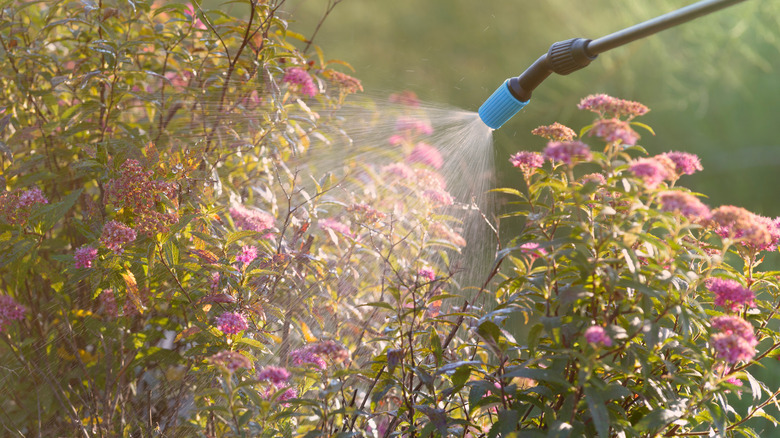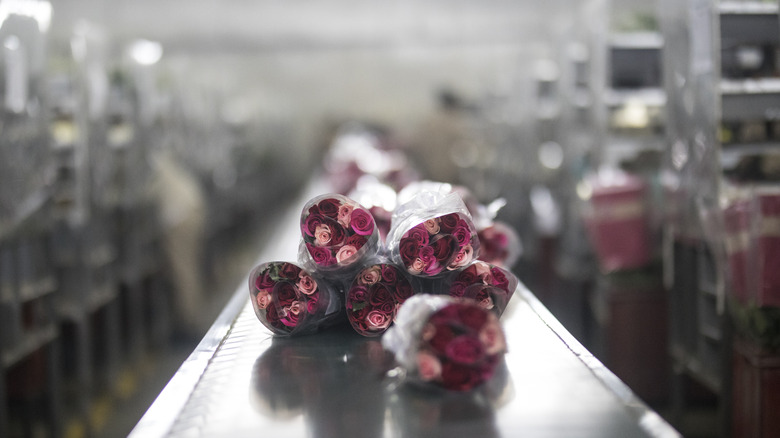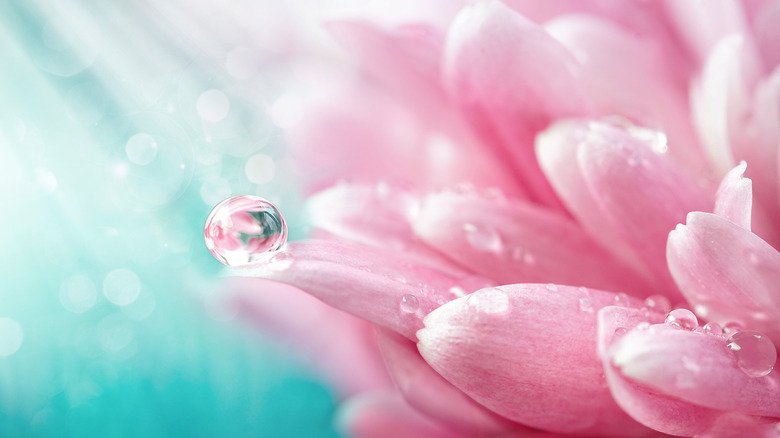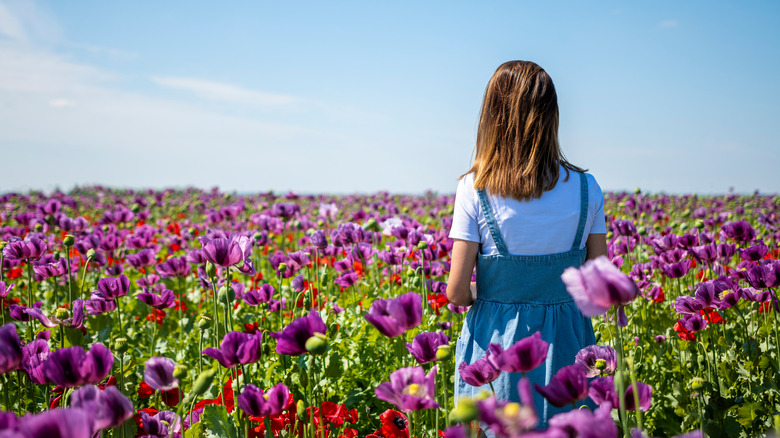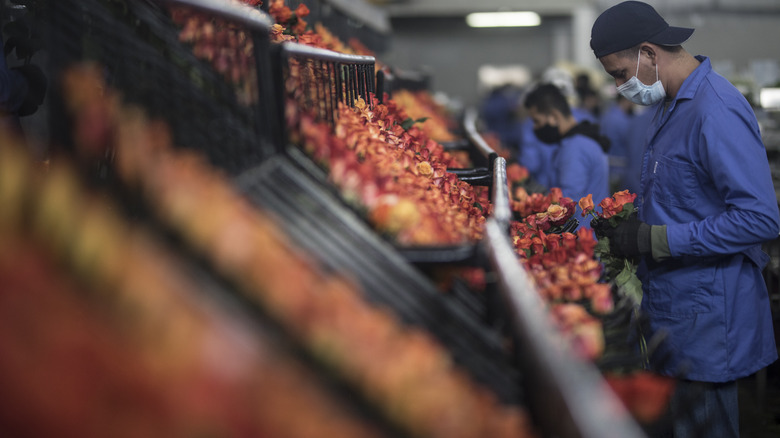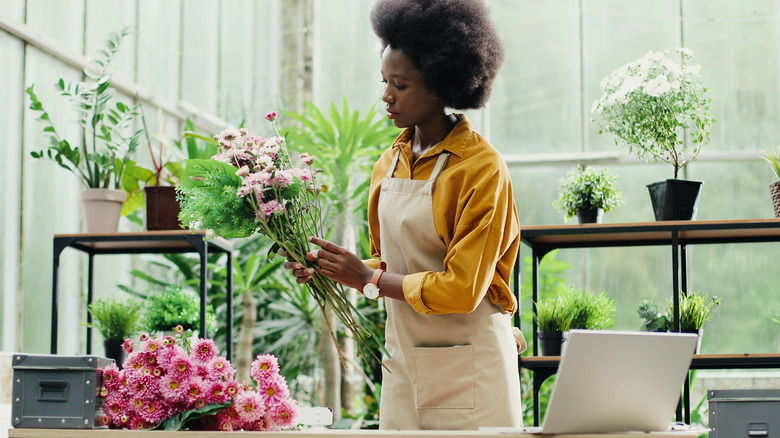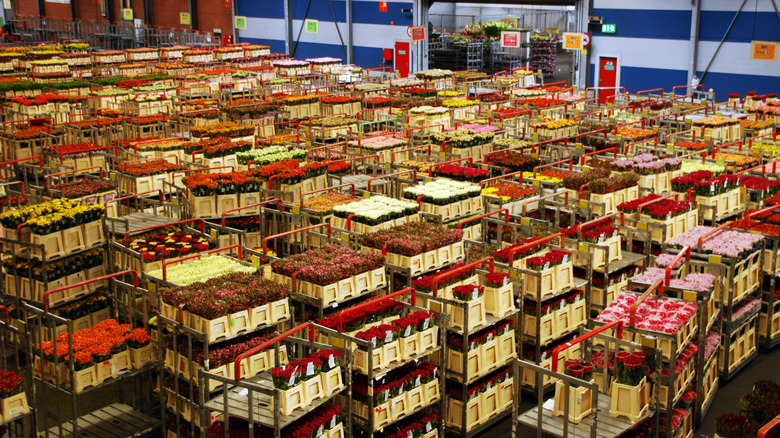Dark Secrets Of The Flower Industry Revealed
Walk into any convenience, gas, or grocery store, and you'll be greeted by a gorgeous array of cut flowers. It's almost impossible to resist grabbing a bouquet, even if there's no special occasion lurking just around the corner. Any home is brightened by a bunch of flowers, after all ... even if it means the inevitable cursing that comes with somehow crushing them with everything in your cart.
The global cut flower industry is almost ridiculously huge. According to PR Newswire, the U.S. market was valued at a whopping $6 billion in 2020, and it's growing so fast that projections suggested it was going to hit $43.8 billion by 2027. Who would have thought there was so much tied up in cut flowers? But the cut flower industry isn't all roses. While the end result — colorful blooms — might be beautiful, what goes on before those flowers get to the grocery stores is incredibly dark. The industry impact goes a long, long way, and it's dark enough that it might just make you rethink grabbing that bouquet for the kitchen counter.
Those flowers come from a long way away
Think buying flowers at the grocery store is supporting a U.S.-owned greenhouse? It would make sense. Flowers don't last forever, particularly after they're cut, and it seems logical that stores would source their bouquets from within the continental U.S. But not so fast: According to The New York Times, the majority of cut flowers sold in the U.S. come from either Kenya, Colombia, Ecuador, or the Netherlands. And this bit of background isn't just weird — it's necessary for talking about the full extent of the horribleness of the industry.
It wasn't always this way. The Smithsonian says that it was one Colorado State University grad student, David Cheever, who was really to blame. Indeed, the landscape of the cut flower industry changed when Cheever wrote a paper on how Colombia was the perfect place to grow flowers. It had everything from a perfect climate to rich soil, and here's the thing: it's actually closer to the eastern half of the U.S. than California. He wrote the paper in 1967, decided to take his own advice and open a growing business in 1969, and everything changed.
Greenhouse Product News says that things immediately went downhill for U.S. growers, especially when companies started looking at their bottom line. After all, South American greenhouses and farms could pay their workers a fraction of what U.S.-based employees wanted, and money talks.
Working conditions are terrible
The company that David Cheever — who's now retired — started is called Floramerica, which is located in Facatativa, Colombia (via Smithsonian) The area is one of the country's biggest exporters of cut flowers, and while it seems like bringing jobs to any city is a win-win, in this case, it hasn't been.
The greenhouses of multiple companies employ about 100,000 people, but those people are laboring under crippling working conditions. Tasks are divided into small, repetitive movements — like trimming stems — that result in severe repetitive stress injuries. Hours are long (with many working 16-hour days, says TED), and most employees earn about $250 a month. Flower industry workers in Kenya labor under similar conditions. As David Musyoka explained to Equal Times: "We cannot afford to feed our families despite all this hustle in the flower farms. ... We are paid about $70 a month, depending on our skills."
Some attempts at improving working conditions have had dire consequences. Smithsonian spoke to a woman who had lost her job after 19 years when the company restructured to break up attempts to unionize. She also claimed they had drained a 20-year-old employee support fund, taking the cash value from $840,000 down to $8,000. (The company did not respond to requests for comment.)
Scores of female employees have reported instances of sexual harassment. According to The Atlantic, surveys suggest that 55% of female flower workers had reported some kind of harassment, and 19% had been forced into sex.
If you or anyone you know has been a victim of sexual assault, help is available. Visit the Rape, Abuse & Incest National Network website or contact RAINN's National Helpline at 1-800-656-HOPE (4673).
The consequences for workers and their health can be devastating
Anyone who's tried to keep their gardens growing knows that flowers are finicky, and this ultimately means it's the employees and the surrounding communities of large-scale growers that are paying a steep price.
Vice took a look behind the scenes at growing operations in Colombia and found that not only did the industry rely on tons of fungicides, fertilizers, and pesticides, but many of the products being used were so toxic that they were banned in Europe and North America. The publication spoke with greenhouse workers who regularly suffered from everything from skin discoloration and rashes to headaches and other chronic illnesses. Sometimes, it turned deadly: One woman recounted the story of a coworker who died after turning purple and collapsing mid-shift. The company wrote it off as a heart attack, but his fellow employees said they knew better — it was the chemicals.
It's not just hearsay, either. ABC News reported that one pesticide-related incident in 2003 impacted 200 workers and sent many to the hospital, where three remained for several days. Research published in the journal Environmental Health Perspectives connected the chemicals used in Ecuador's flower industry with things like high blood pressure and an increased risk of cardiovascular disease in children born to women who had been exposed to the pesticides and fungicides. According to Vice, a link has also been found between the chemicals and an increased rate of things like birth defects and miscarriages.
Doctors are accused of downplaying health risks
The theory is that when someone doesn't feel good, they should be able to go to a doctor with their complaints — even (and especially) if there's a sneaking suspicion it's something at work that's making them sick.
Mother Jones took a hard look at Ecuador's cut flower industry and found two very different sides to the same story. While bosses boasted of their high pay rates, the protective gear they gave employees, and lack of problems with things like chemical poisonings, some — like Dr. Toribio Valladares, a medical professional who heads up the area's Red Cross — tell a different tale. He's one of the few who does speak up, as employees (and some company managers) have come forward to share the terrifying idea that speaking out against poor working conditions is enough to get a person blacklisted out of the industry. And in a place where there are not many other options, that can mean the end of a livelihood.
Many local doctors are reportedly hired by flower producers and are paid a regular consultancy fee to stay there. The idea is that corporations are paying medical professionals to stay and provide healthcare for workers, and while that sounds like a great idea, Valladares told Mother Jones, "Corruption is everywhere." He sees a system where doctors are paid to treat symptoms and keep everything quiet, and in the end, it's one where vulnerable workers are left without a voice.
The pollutants are destroying the environment, too
A 2021 piece published in Environmental Pollution reported on some shocking findings, including the fact that researchers had identified around 200 different chemicals frequently used — and often overused — in the flower industry. That overuse came because of a bit of a gap in legislation: Since flowers are classified as ornamental instead of edible, the same rules and regulations that govern the use of chemicals on food crops don't apply.
The precise environmental consequences of pollutants from the flower industry aren't known, but let's take a look at Kenya's Lake Naivasha. In 2010, Circle of Blue reported that the lake was dealing with giant algal blooms, massive fish die-offs, and at the time, one of the major factors being blamed was the area's flower farms. While they — and the government — denied that runoff from pesticides and fertilizers was to blame, DW said otherwise when they looked at the situation eight years later. Local fishermen had suddenly found the lake almost barren, and when they were interviewed by the outlet in 2018, they recalled the previous difficulties: "It took the Department of Fisheries one year to regenerate the fish stock," explained Samson Macharia. "People went hungry."
DW's report, too, pointed the finger at the multiple flower producers set up around the lake. In spite of the fact that stricter regulations were put in place after 2010, locals say that it hasn't really made a difference, and their waters are still being polluted ... by something.
The carbon footprint is massive
When it comes to cut flowers, there's nothing about them that's actually good for the environment. Let's start with a report from The International Council on Clean Transportation. When it looked at the environmental impact of moving millions of flowers from growers to buyers, figures were pretty astronomical. TED explains all their numbers and figures like this: The transportation of just shipping Valentine's Day flowers from Colombia alone was, in 2018, the equivalent of putting an additional 78,000 cars on the road for an entire year.
Think buying locally is the way to avoid that? Not so fast. To make a flower crop worthwhile, they have to be grown under the right conditions — and for many greenhouses in the U.S., that means running heaters to keep the temperature high enough to get all those brilliant blooms. They also tend to need more chemicals and fertilizers, and that's such a big deal that Fairtrade International says that U.S.-grown flowers can have a carbon footprint that's up to 5.5 times higher than those grown in other countries and flown in. Bottom line? It's a lose-lose.
The water use is astronomical
When Circle of Blue looked at the devastation that was hitting the area around Kenya's Lake Naivasha in 2010, one of the problems was a decreasing water level. There were two different explanations for what was going on: While some strictly blamed the drought conditions the area had been suffering from, others pointed the finger at the nearby flower farms that were using the lake for irrigating their crops. As it turns out, the cut flower industry uses a shocking amount of water. According to The Guardian, a single rose requires 10 liters of water.
The entire issue is hugely complicated, and here are some facts from the Institute for Agriculture & Trade Policy to put things in perspective: Over 900 liters of water go into just a single liter of milk, so switching land use to other uses might seem like a great idea. But not all crops are created equal, and the flowers planted for the cut flower industry consume about 20 times more water than things like cotton, rice, and wheat. The issue has also helped shine the light on a weird phenomenon: virtual water export. It's essentially the movement of the water that goes into making a product, and it's a huge deal. Science writer and author Fred Pearce suggests that when looking at the water use that goes into what every person consumes on a daily basis, we each use about 100 times our own weight in water — every single day.
Child labor is widespread
There are certain times of the year when the production of cut flowers really ramps up, and that includes Valentine's Day. Countless people might love getting a Valentine's Day bouquet, but The Atlantic puts things in a rather heartbreaking perspective by sharing their findings on child labor in the industry — one in every 12 flowers was cut and processed by a child. Not only are workers forced into unthinkable 20-hour workdays to keep up with demand, but here's another eye-opening statistic relayed by the Smithsonian: In the mid-1990s, investigations of flowers farms in Colombia found 9-year-old children working there on weekends, and others as young as 11 were working 46-hour-a-week jobs there.
That has, thankfully, changed — at least, in Colombia. George W. Bush's 2006 free trade deal with Colombia added a requirement that they had to abide by certain standards, and that meant putting an end to child labor. Still, those living in other countries haven't been as fortunate. In 2014, the International Justice Mission reported that they were involved in rescuing a group of boys — aged 9 to 15 — from a rose farm in Bangalore, India. Every day, they had been tasked with caring for 4,000 roses and were severely beaten if they so much as broke a flower.
Disruption can be shockingly devastating
As far as the industry goes, the cut flowers business is still fairly new. In 2020, the big flower-exporting countries and communities saw just what kinds of damage a slowed or shut down industry can do, and it's way worse than many people might think.
A lot of priorities changed when COVID-19 hit, and when people stopped buying flowers not just for their kitchen tables but for the kind of large-scale events — like weddings — that were suddenly put on hold, it was catastrophic. In just the first six weeks of lockdown, the BBC says the global industry lost about $1.2 billion, and the hardest hit were those at the bottom.
That's largely because the hundreds of thousands of farmworkers are barely paid a pittance to begin with, and when that disappears, they're left with nothing — no income, and certainly no savings. The Fairtrade Foundation reported that workers in countries like Kenya were so hard-hit by the downturn that it was considered a "humanitarian crisis," and no one should ever be just six weeks away from that.
Experts say that the pandemic only exposed weaknesses and vulnerabilities that were already there, leaving it up to the industry to do something about it.
Think you're buying local? Not so fast
Everyone loves to buy local and support businesses in their own backyard, but in 2019, Australia's florists were pushing for government action into what they called deceptive advertising by national cut flower companies.
They claimed that nationwide companies advertised themselves with local phone numbers and names and took online or phone orders from customers who fully believed they were supporting a local business (via the Australian Broadcasting Corporation). Then, the company would contract out with actual, local florists, have them fill the order, and keep a hefty percentage of the price. Meanwhile, small florists were losing tens of thousands of dollars, even though they were the ones that were still doing all the work.
The accusations didn't go away, and by 2021, former employees of large companies came forward to testify that it was definitely a practice and that they had been trained on how to take orders while letting customers believe that it was a local business that was getting their entire order and payment (per the Australian Broadcasting Corporation). Training materials apparently told them: "DON'T LIE. Be positive, embellish, reaffirm but don't lie." After dodging any questions about where shops were located, they were taught how to quickly change the subject. Consumer watchdog groups were very concerned, suggesting that their investigations were perhaps just the tip of the iceberg.
There have been links to the mafia
In 2015, The Independent reported that a massive investigation into the Italian Mafia group 'Ndrangheta had culminated in the arrest of 54 people for their involvement in an operation that moved flowers, chocolates, and cocaine across Europe. The group "controlled vast segments of the Dutch flower market," a statement from law enforcement said. Money was sent to the Netherlands, and trucks of flowers and cocaine returned. Rome prosecutor Michele Prestipino explained that the Mafia's involvement in otherwise legitimate businesses was nothing new: "It has a great ability to adapt itself to what the market offers and predict what sectors are going to be big," he told La Stampa (per The Independent).
And that's the flower industry. The following year, Reuters reported that law enforcement was still trying to get 'Ndrangheta's foothold out of the Dutch flower market. The publication reported that along with the flowers, some traders at the Royal FloraHolland (pictured above) flower market were using their business as a front and their trucks to transport large quantities of drugs and weapons. The flower business in question was near both Schiphol Airport and Rotterdam's port: Drugs would come in from overseas, cargo containers would be received into the otherwise legit business and transferred onto trucks with the flowers, and then they were sent onwards through the 'Ndrangheta's supply chain to the tune of a few trucks a week.
